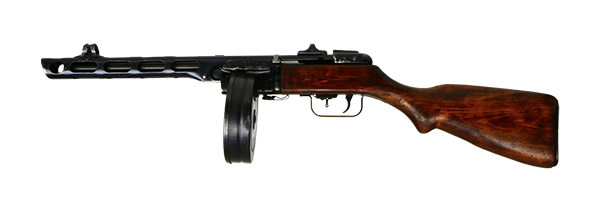
This image has format transparent PNG with resolution 600x210.
You can download this image in best resolution from this page and use it for design and web design.
PPSh-41 PNG with transparent background you can download for free, just click on download button.
The PPSh-41 (pistolet-pulemyot Shpagina; Russian: Пистолет-пулемёт Шпагина; "Shpagin machine pistol"); is a Soviet submachine gun designed by Georgy Shpagin as a cheap, reliable, and simplified alternative to the PPD-40. Common nicknames are "pe-pe-sha" (Russian: ППШ) from its three-letter acronym and "papasha" (Russian: папаша), meaning "daddy".
The PPSh is a magazine-fed selective fire submachine gun using an open bolt, blowback action. Made largely of stamped steel, it can be loaded with either a box or drum magazine and fires the 7.62?25mm Tokarev pistol round.
The PPSh saw extensive combat use during World War II and the Korean War. It was one of the major infantry weapons of the Soviet Armed Forces during World War II. Around six million PPSh-41s were manufactured. In the form of the Chinese Type 50 (licensed copy), it was still being used by the Viet Cong as late as 1970. According to the 2002 edition of the Encyclopedia of Weapons of World War II the PPSh was still in use with irregular militaries.
The PPSh-41 fires the standard Soviet pistol and submachine gun cartridge, the 7.62x25mm (Tokarev). Weighing approximately 12 pounds (5.45 kg) with a loaded 71-round drum and 9.5 pounds (4.32 kg) with a loaded 35-round box magazine, the PPSh is capable of a rate of about 1000 rounds per minute, a very high rate of fire in comparison to most other military submachine guns of World War II. It is a durable, low-maintenance weapon made of low-cost, easily obtained components, primarily stamped sheet metal and wood. The final production PPShs have top ejection and an L type rear sight that can be adjusted for ranges of 100 and 200 meters. A crude compensator is built into the barrel jacket, intended to reduce muzzle climb during automatic fire. The compensator was moderately successful in this respect, but it greatly increased the muzzle flash and report of the weapon. The PPSh also has a hinged receiver to facilitate field-stripping and cleaning the weapon. A chrome-lined bore enables the PPSh to withstand both corrosive ammunition and long intervals between cleaning. No forward grip or forearm was provided, and the operator generally has to grasp the weapon behind the drum magazine with the supporting hand, or else hold the lower edge of the drum magazine. Though 35-round curved box magazines were available from 1942, the average Soviet infantryman in World War II carried the PPSh with the original 71-round drum magazine.
The PPSh drum magazine holds 71 rounds. In practice, misfeeding is likely to occur with more than about 65. In addition to feed issues, the drum magazine is slower and more complicated to load with ammunition than the later 35-round box magazine that increasingly supplemented the drum after 1942. While holding fewer rounds, the box magazine does have the advantage of providing a superior hold for the supporting hand. Although the PPSh is equipped with a sliding bolt safety, the weapon's open-bolt design still presents a risk of accidental discharge if the gun is dropped on a hard surface.
In this page you can download free PNG images: PPSh-41 weapon PNG images free download